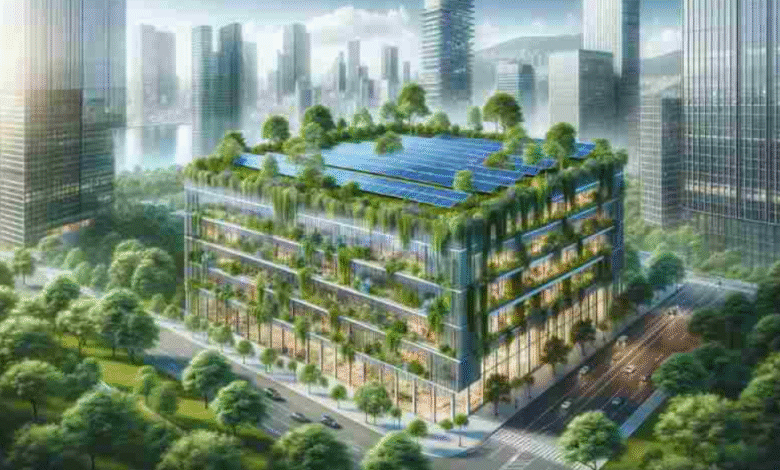Pioneering Green Construction Transformations to Forge a Sustainable Legacy

In an era where the planet’s health is at the forefront of global priorities, the construction industry is undergoing a transformation. The shift towards sustainable building practices is not only a response to rising environmental concerns but a lucrative business opportunity for those ready to innovate. Imagine being at the helm of a company that not only contributes to the well-being of the planet but also meets the burgeoning market demand for eco-friendly construction. This article serves as your guide to entering the thriving world of sustainable construction, offering insights into market trends, innovative business models, and the strategic use of technology to build a successful and sustainable enterprise.
Unveiling the Green Wave Discovering the Demand for Eco-Friendly Buildings
When you evaluate the market demand for green building solutions, you’ll find that the industry is experiencing robust growth driven by increasing environmental awareness and government regulations. Significant advancements in eco-friendly technologies and a rise in sustainable construction practices are key contributors to this expansion. Such promising growth underscores a surging demand that makes venturing into green building solutions both timely and potentially lucrative for aspiring businesses.
See also: Exploring the Role of 7737025564 in New Age Tech Solutions
Designing Tomorrow Crafting Sustainable Business Models
To build an eco-friendly enterprise, you must align your business model with environmental objectives, ensuring it contributes positively to ecological sustainability. Embracing sustainable business models not only meets regulatory demands but also enhances competitiveness and profitability. By integrating circular economy principles, you can create products that are reusable, repairable, and recyclable, reducing waste and fostering a resilient business environment. Additionally, adapting your operations to meet ecological goals can tap into this growing market segment. Moreover, involving stakeholders in sustainability initiatives and leveraging planning tools can guide you in continuously improving and modernizing your operations for greater environmental impact and business growth.
Navigating Complexity Understanding the Certification Maze
When starting a business in sustainable building, it is crucial to navigate through the intricate regulatory and certification landscape efficiently. In the United States, green building certifications, such as LEED certification, are guided by a set of prerequisites and points that you must fulfill to earn different levels of recognition. These certifications are not federally mandated but are instead managed at the local level, reflecting regional policy variations and sustainable practices. Meanwhile, in Europe, regulatory frameworks are more stringent, requiring nearly zero-energy buildings (NZEB) and establishing cost-optimal energy performance standards as part of long-term decarbonization strategies. Understanding these nuances and strategically aligning your projects with local requirements and certification programs will not only ensure compliance but also position your business as a leader in the sustainable construction industry.
Innovating Impactful Techniques for Sustainable Building
When embarking on a business centered around environmentally sustainable buildings, embracing innovative design and construction techniques can significantly minimize environmental impact. By utilizing prefabricated and modular components, you can decrease material waste and enhance energy efficiency due to precise, factory-controlled production methods. This approach complements the rising trend of eco-friendly materials, such as bamboo, which not only offer a renewable resource for construction but also reduce reliance on concrete. Additionally, adopting smart technology and advanced insulation materials further enhances your project’s energy efficiency, contributing to the development of net-zero energy buildings. As these techniques become more prevalent, aligning your business strategy with these trends can differentiate your offerings in the growing market of sustainable construction.
Empowering Green Construction with Technology and Renewables
In the realm of green building projects, the integration of advanced technology and renewable energy stands as a cornerstone for creating environmentally sustainable structures. By employing innovations such as energy-efficient solar panels and LED lighting, you can significantly lessen a building’s ecological footprint and contribute to long-term sustainability. The move towards self-sufficient structures, featuring solar power generation and energy storage, enhances a building’s independence from traditional power grids, as noted by efforts in both green building practices and substantial megaprojects in renewable energy. This technological symbiosis not only ensures compliance with regulatory frameworks but also aligns with global endeavors to achieve sustainable urban growth and reduced carbon emissions.
Building Bridges Fostering Collaboration in Green Construction
Creating a successful green building enterprise hinges on developing robust partnerships with stakeholders across the construction industry. You must foster a collaborative environment, as green building involves various stakeholders who support the integration of sustainable practices throughout the building lifecycle. Embracing an Integrated Construction Process (ICP) model is essential, as it facilitates the seamless execution of sustainable strategies, ensuring both environmental and economic goals are met. Engaging with stakeholders not only builds a strong network for innovation but also addresses complexities arising from differing interests and personalities, which can otherwise impede project success. By leveraging diverse expertise and promoting inclusive dialogue, your green building business can navigate the challenges of sustainability and achieve its aims effectively.
Captivating Imagery Crafting Engaging Marketing Visuals
To effectively market your sustainable building business, you should focus on crafting captivating product photographs that highlight your commitment to eco-friendly practices. By employing an online background eraser, you can enhance the focus on your green construction materials, ensuring customers see your products and not distracting backgrounds. This tool not only improves the clarity and appeal of your images but also allows for versatile placement on different backgrounds or in varying environments, making your marketing materials more dynamic and engaging. Additionally, lifestyle product images can be incorporated to show your product in real-world, sustainable settings. This approach not only boosts your brand’s visual storytelling but also aligns with the growing consumer preference for authenticity and eco-friendly solutions.
The journey towards establishing a thriving sustainable construction business is more than just an entrepreneurial venture—it’s a commitment to fostering a legacy of eco-friendly innovation. As you pave your path in this burgeoning industry, remember that each step towards sustainability creates ripples that extend beyond improved business metrics to tangible impacts on communities and the environment. With determination and a forward-thinking mindset, you can not only meet market demands but also inspire change and set new standards for what is possible. Your efforts embody the spirit of transformation, powering an era where building green is synonymous with building smartly for the future. Embrace this opportunity to leave an indelible mark on the world.



